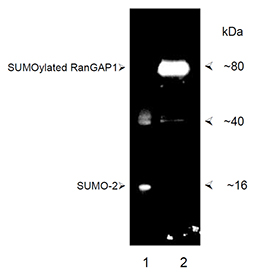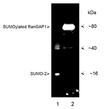Product Details
| Alternative Name: | Small ubiquitin-related modifier 2/3 |
| |
| Host: | Rabbit |
| |
| Immunogen: | Synthetic peptide corresponding to aa 1-15 of human SUMO-2. |
| |
| UniProt ID: | P61956 |
| |
| Source: | Purified from rabbit serum. |
| |
| Species reactivity: | Human
|
| |
| Applications: | WB
|
| |
| Recommended Dilutions/Conditions: | Western Blot (1:1,000)
Suggested dilutions/conditions may not be available for all applications.
Optimal conditions must be determined individually for each application. |
| |
| Purity Detail: | Partially purified by salt precipitation. |
| |
| Formulation: | Liquid. In PBS containing 0.01% sodium azide. |
| |
| Shipping: | Blue Ice |
| |
| Long Term Storage: | -20°C |
| |
| Scientific Background: | The small ubiquitin-related modifier SUMO belongs to the growing family of ubiquitin-related proteins involved in post-translational protein modification. It is present in all eukaryotic kingdoms and is highly conserved from yeast to humans. Two ubiquitin like proteins, SUMO-2 and SUMO-3 have been identified that are related to SUMO-1 but which are functionally distinct. Whereas invertebrates have only one SUMO gene, three members of the SUMO family have been described in vertebrates, SUMO-1 and the close homologues SUMO-2 and SUMO-3 with some 50% homology between SUMO-1 and SUMO-2/3, and 86% identity between SUMO-2 and SUMO-3. The SUMO family members have a short N-terminal extension that is absent in ubiquitin, and the function of which is unknown and the sequence of which varies between the three family members. In vivo studies have indicated that PML is modified by SUMO-1 and SUMO-2/3, although the functional significance of SUMO-2/3 conjugation has not been revealed. Functional SUMO modification sites present in the N-terminal regions of SUMO-2 and SUMO-3 are utilised by SAE1/SAE2 (SUMO E1) and Ubc9 (SUMO E2) to form polymeric chains of SUMO-2 and SUMO-3 on protein substrates in vitro and SUMO-2 chains have been detected in vivo. The ability to form polymeric chains is not shared by SUMO-1. Thus, although all SUMO species share the same conjugation machinery, modification by SUMO-1 and SUMO2/3 has distinct functional consequences which are only now beginning to be defined more clearly. |
| |
| Technical Info/Product Notes: | The antiserum to SUMO-2 was raised in New Zealand White rabbits to a synthetic peptide corresponding to amino acid residues 1-15 of human SUMO-2. The antibody has been partially purified by salt precipitation and is suspended in PBS containing 0.01% sodium azide as a preservative. BML-PW9465 has been characterised for specificity against various members of the ubiquitin-like protein family including ubiquitin, multi-ubiquitin chains, SUMO-1, UCRP, Nedd8, and FAT10. This antibody shows no cross-reactivity with any of these Ubl proteins upon Western blotting under the conditions tested.
Reactivity of the antibody with both pro- and mature forms of SUMO-2 is completely abolished by preincubation of the antibody with its cognate peptide (product code BML-PP9480). For Western blot an initial dilution of at least 1:1000 is recommended. BML-PW9465 has not been characterised for use in immunoprecipitation or immunohistochemical applications. |
| |
| Regulatory Status: | RUO - Research Use Only |
| |

Western Blot Analysis: SUMOylation assay utilising His6-tagged SUMO-2 (BML-UW9205), SUMO E1 (BML-UW9330), SUMO E2 (BML-UW9320) and RANGAP1 as substrate in presence (lane 2) and absence (lanes 1) of ATP after SDS-PAGE and blotting to PVDF with subsequent probing with BML-PW9465.
Please mouse over
Product Literature References
Epac1 activation by cAMP regulates cellular SUMOylation and promotes the formation of biomolecular condensates: W. Yang, et al.; Sci. Adv.
8, eabm2960 (2022),
Abstract;
The axonal motor neuropathy-related HINT1 protein is a zinc- and calmodulin-regulated cysteine SUMO protease: E. Cortes-Montero, et al.; Antioxid. Redox Signal.
31, 503 (2019),
Abstract;
ATPase-Dependent Control of the Mms21 SUMO Ligase during DNA Repair: M. Bermúdez-López, et al.; PLoS Biol
13, e1002089 (2015),
Application(s): Assay,
Abstract;
Full Text













